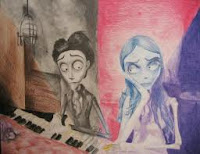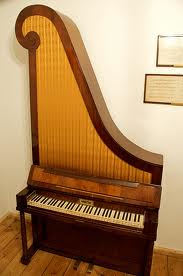On the Value of Exercises
A pianist writes: "I have been told by some pianists that Hanon's "The Virtuoso Pianist, In Sixty Exercises" is a waste of time....it's stupid and nonsense. One pianist even asked me, "Do you think Tchaikovsky or Mozart played these? Throw the book away."
On the other hand, a piano student studying for her phd in piano performance told me that she plays them every day and that she believes it helps her playing?
What is the general consensus on this? I believe if it works for you then by all means play it. However if that's the case then should all teachers teach all their students Hanon?"
My response: What do you mean by works for you? When playing something (an exercise) that is supposed to prepare you for something else (a piece of music), I think it's important to ask yourself why? What is the purpose of this particular exercise?
Unfortunately, Mr. Hanon only gives metronome indications and says to repeat the exercises. He doesn't really tell us how to play the exercises, except to lift the fingers high(!). He tells us that they will produce agility, strength(!), independence and evenness.
The mindset from which this point of view stems has largely been replaced over the years, although some still cling doggedly to it, i.e., that it takes physical strength to play the piano. It does not. (A small child can do it.) We gain power not by lifting the fingers away from the hand, which is something they weren't designed to do efficiently, but rather with the discreet participation of the forearm. Hanon's supposition is that by lifting the fingers they will become strong and independent, but we don't train like weight lifters train, by building muscle mass. Rather, we train for refined coordination. The fingers never will be independent of each other, nor need they be; they can, however, be made to sound that way.
In short, "you can play whatever you want, dear," to quote my teacher, but once you know how to play the exercises correctly, i.e., with the participation of the forearm, there is no longer any reason to play them. In fact, there's no point in playing them at all because the technical issues can be addressed in music.
As for the Phd candidate, that routine may serve several purposes: provide a comforting and mindless routine, a delay tactic for avoiding the real work to come or some other obsessive/compulsive purpose. In graduate school I knew a wonderful pianist who drilled scales for hours. Her scales were indeed perfection and she played the 4th Beethoven concerto like an angel. But the same compulsion that drove her to drill those scales, and they were beautiful, drove her into some sort of breakdown and when I last heard she had given up the piano entirely and joined a protective order of some sort. Admittedly, that is an extreme case and this particular pianist was apparently troubled. Playing Hanon won't necessarily cause so severe a reaction and probably won't case any particular harm, unless the idea of lifting fingers is taken to extremes.
Later in the post someone writes:
"Any system, method, or approach is only as good as the teacher and the student practicing. The success probably goes beyond the method. I think that if something is repetitive, and if the person practicing it is wrongly guided or self-guides, there might be harm because a wrong motion done repeatedly will hurt. At the same time, if a right motion is well-guided, then you have a well-practiced set of right motions that will serve you well."
My Response:
You are right. But just as the success goes beyond the method, so too do the failures. By failures I mean conceptual misunderstandings. Perhaps this is what you mean by practicing "wrongly." But it's more than practicing wrongly. (Please don't think I'm just being argumentative here. I'm genuinely concerned about this issue.)
The concept inherent in exercises in general is that repetition of note patterns will create strong fingers or independent fingers or that these patterns will occur in the same way in music. These ideas date from the 1880's and have their origins in the experience of keyboard players who were steeped in harpsichord techniques. I believe Czerny and Hanon and the others were probably sincere, although I don't completely discount the notion that money was to be made off of the burgeoning piano market. When Hanon, for example, was popular and adopted by so many institutions, Matthay had not yet written about the use of the forearm. Keyboard players thought primarily about lifting fingers, despite Schumann's unfortunate experience. (Google Landowska's photo of her claw-like hands.)
If you discard Hanon's "instructions," as I believe all pianists should, the exercises can be used to show how patterns can be grouped together for technical ease, how to shape. But I learned these techniques in a Mozart sonata (K. 333). If you don't believe in lifting the fingers away from the hand (as he instructs) or training for strength and therefore using repetition for endurance (wrong concepts), then I implore you to ask yourself what specifically you hope to gain by practicing Hanon.
Let me be clear: I don't think the exercises themselves are "dangerous" and carcinogenic (LOL) but the underlying concepts that students take away are not in sync with a system of playing that uses the body efficiently, the way it was designed to be used. Students invariably take away the idea that repetition of patterns is the key to success, when the "working-in" of specific, local and correct physical movements is the key to success. By "local" I mean "what do the finger, hand, arm do in this spot to get easily and efficiently from here to there?" This, of course, requires knowledge of the working mechanism (but one doesn't have to be a doctor).
It is possible to play the piano with great success using many different points of view, or from no point of view at all. I choose to use a specific physical approach that allows my hands to be used according to their design. The fingers are strong and sound independent if the forearm is allowed to play its part, and there is nothing wrong with the 4th finger, just in case anyone was wondering.
Later in the post someone writes:
"Any system, method, or approach is only as good as the teacher and the student practicing. The success probably goes beyond the method. I think that if something is repetitive, and if the person practicing it is wrongly guided or self-guides, there might be harm because a wrong motion done repeatedly will hurt. At the same time, if a right motion is well-guided, then you have a well-practiced set of right motions that will serve you well."
My Response:
You are right. But just as the success goes beyond the method, so too do the failures. By failures I mean conceptual misunderstandings. Perhaps this is what you mean by practicing "wrongly." But it's more than practicing wrongly. (Please don't think I'm just being argumentative here. I'm genuinely concerned about this issue.)
The concept inherent in exercises in general is that repetition of note patterns will create strong fingers or independent fingers or that these patterns will occur in the same way in music. These ideas date from the 1880's and have their origins in the experience of keyboard players who were steeped in harpsichord techniques. I believe Czerny and Hanon and the others were probably sincere, although I don't completely discount the notion that money was to be made off of the burgeoning piano market. When Hanon, for example, was popular and adopted by so many institutions, Matthay had not yet written about the use of the forearm. Keyboard players thought primarily about lifting fingers, despite Schumann's unfortunate experience. (Google Landowska's photo of her claw-like hands.)
If you discard Hanon's "instructions," as I believe all pianists should, the exercises can be used to show how patterns can be grouped together for technical ease, how to shape. But I learned these techniques in a Mozart sonata (K. 333). If you don't believe in lifting the fingers away from the hand (as he instructs) or training for strength and therefore using repetition for endurance (wrong concepts), then I implore you to ask yourself what specifically you hope to gain by practicing Hanon.
Let me be clear: I don't think the exercises themselves are "dangerous" and carcinogenic (LOL) but the underlying concepts that students take away are not in sync with a system of playing that uses the body efficiently, the way it was designed to be used. Students invariably take away the idea that repetition of patterns is the key to success, when the "working-in" of specific, local and correct physical movements is the key to success. By "local" I mean "what do the finger, hand, arm do in this spot to get easily and efficiently from here to there?" This, of course, requires knowledge of the working mechanism (but one doesn't have to be a doctor).
It is possible to play the piano with great success using many different points of view, or from no point of view at all. I choose to use a specific physical approach that allows my hands to be used according to their design. The fingers are strong and sound independent if the forearm is allowed to play its part, and there is nothing wrong with the 4th finger, just in case anyone was wondering.


















